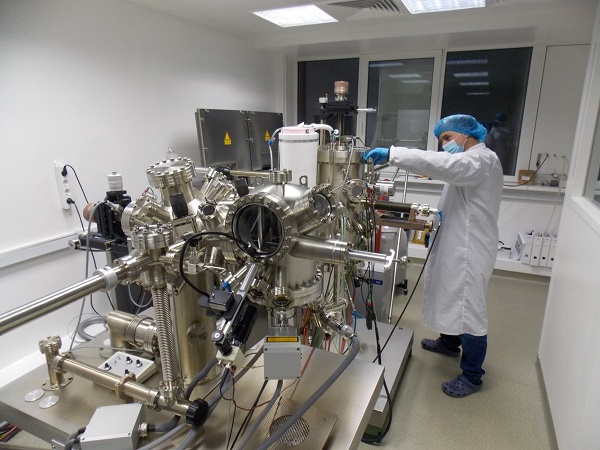Epitaxial film deposition by MBE
Researcher: Radu Tiberiu Brătfălean
Keywords: ultra-high vacuum evaporation, thin film deposition, crystalline films, molecular epitaxy
Keywords: ultra-high vacuum evaporation, thin film deposition, crystalline films, molecular epitaxy

Ultra-high vacuum epitaxial film deposition by MBE (Molecular Beam Epitaxy) technique is a fabrication technology by which a film, from a material of interest, can be grown on a deposition substrate. The substrate is chosen both to favor the single crystal structure of the film and to provide the necessary adhesion.
The deposition of the film is achieved by sending a beam of atoms/molecules onto the substrate. This beam is obtained by thermal evaporation of the material of interest in an electrically heated crucible, thus ensuring a well-defined directionality of the beam on the deposition substrate. The deposition process takes place under ultra-high vacuum conditions at pressures of the order of 10-10 mbar in order to achieve a high purity of the material in the deposited film.
Areas of application: R&D, electronics, optoelectronics, nanotechnologies.
Systems: the materials that can be deposited by this technique are metals, semiconductors, and any other inorganic and organic materials in solid state that have a sufficiently high evaporation rate up to the maximum heating temperature of about 1450ºC.
Industries: semiconductor devices, telecommunications, sensors, lasers.
The Institute’s Department of Molecular and Biomolecular Physics has a state-of-the-art molecular epitaxy facility, which was purchased in March 2012 from Omicron in Germany. The main technical features of the facility are as follows:
Diagnosis at every stage of manufacturing. The molecular epitaxy facility is coupled to another ultra-high vacuum facility which has AFM and STM scanning microscopy facilities. This allows both the characterization of the substrate topography and the topography of the deposited films immediately after their fabrication, without the sample leaving the ultra-high vacuum environment
Substrate temperature control. This makes it possible to ensure the required substrate temperature during deposition, and to perform thermal treatments on the sample. These thermal treatments can be performed both prior to deposition, for degassing and pyrolytic cleaning of the substrate, and after deposition, for example to achieve desired micro-/nanostructuring effects of the deposited films
Argon ion treatment. Equipping the molecular epitaxy installation with the argon ion gun allows more aggressive cleaning of the deposition substrate. This is necessary when there are contaminants that are strongly bound to the deposition substrate and could not be removed by the traditional method of sonication in various chemical solvents
The price for the realization of an epitaxial thin film deposition starts from 500 lei and can increase depending on the complexity of the desired manufacturing process. Factors influencing the price of an epitaxial thin film deposition process are as follows: